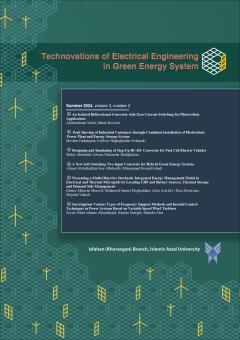Mal-Operation of Distance Relay in Parallel Cable Lines of Sub-Transmission Network Due to the Effect of Reverse Fault Current in the Direction of Load Flow
Subject Areas : Power EngineeringFarhad Aghajanian Sabagh 1 , Farzad Hajimohammadi 2
1 - Events Studies and Analysis Unit, Technical Office Affairs, Akhtar Bargh Esfahan Company, Isfahan, Iran
2 - Events Studies and Analysis Unit, Technical Office Affairs, Akhtar Bargh Esfahan Company, Isfahan, Iran
Keywords: Mal-operation of distance protection relay, Parallel cable lines, Sub-transmission network, Cable shield grounding,
Abstract :
Mal-operation of distance relays in electric power systems can be caused by a variety of factors, including errors in the relay's hardware or software, incorrect settings, and so on. In this paper, the issue malfunction of distance relay in parallel cable lines of sub-transmission network due to a systemic phenomenon titled "reverse fault current effect in the direction of load flow on the healthy phase" is studied and explored from various aspects. The innovation presented in this article is the detection of described above phenomenon that may cause the distance relay maloperation on a healthy phase of the adjacent line, leading to disconnection of the mentioned line. This is despite the fact that the fault has occurred on only one of the two parallel cable lines, and only that faulted line should be isolated from the network. In this study, we initially provide a comprehensive explanation of this phenomenon and illustrate its impact on the healthy phases of nearby parallel lines. Subsequently, to confirm the occurrence of this phenomenon, a real electrical power network is examined and modeled through DIgSILENT software simulations. Furthermore, we explore and analyze the factors that amplify or mitigate this phenomenon. Concluding the paper, we propose several strategies to mitigate the effects of this phenomenon, thereby preventing the mal-operation of the distance relay.
[1] S. Salehimehr, B. Taheri and M. Faghihlou, “Detection of power swing and blocking the distance relay using the variance calculation of the current sampled data,” Electr Eng, vol. 104, no. 2, pp. 913–927, Jul. 2022, https://doi.org/10.1007/s00202-021-01350-1.
[2] B. Taheri, S. A. Hosseini, and S. Salehimehr, “An overview of power swing detection methods in distance relays and the factors involved,” IET Generation Transmission & Distribution, vol. 17, no. 4, pp. 743–761, Dec. 2022, doi: https://doi.org/10.1049/gtd2.12711.
[3] K. Seethalekshmi, S. K. Singh, and S. C. Srivastava, “A Classification Approach Using Support Vector Machines to Prevent Distance Relay Maloperation Under Power Swing and Voltage Instability,” IEEE Transactions on Power Delivery, vol. 27, no. 3, pp. 1124–1133, Jun. 2012, doi: https://doi.org/10.1109/tpwrd.2011.2174808.
[4] A. Thakallapelli, R. Mehra, and H. A. Mangalvedekar, “Differentiation of faults from power swings and detection of high impedance faults by distance relays,” in 2013 IEEE 1st International Conference on Condition Assessment Techniques in Electrical Systems (CATCON), Dec. 2013, pp. 374-377, doi: https://doi.org/10.1109/catcon.2013.6737530.
[5] S. Arasu and R. Ananthanarayanan, “Mitigating Distance Relay Maloperations during Load Encroachment through an Adaptive Mho Distance Relaying Scheme Based on Sequence Components,” SSRG international journal of electrical and electronics engineering, vol. 10, no. 9, pp. 40–60, Sep. 2023, doi: https://doi.org/10.14445/23488379/ijeee-v10i9p105.
[6] N. K. Rajalwal and D. Ghosh, “Superseding Mal-Operation of Distance Relay Under Stressed System Conditions,” Power systems, pp. 393–421, Sep. 2020, doi: https://doi.org/10.1007/978-3-030-54275-7_15.
[7] H. Mortazavi, H. Mehrjerdi, and M. Saad, “A Modified Load Encroachment Technique for Power Factor Monitoring,” 2018 IEEE Power & Energy Society General Meeting (PESGM), Aug. 2018, pp. 1-5, doi: https://doi.org/10.1109/pesgm.2018.8586366.
[8] T. Ghanizadeh Bolandi, M. R. Haghifam, and M. Khederzadeh, “Real‐time monitoring of zone 3 vulnerable distance relays to prevent maloperation under load encroachment condition,” IET Generation, Transmission & Distribution, vol. 11, no. 8, pp. 1878–1888, May 2017, doi: https://doi.org/10.1049/iet-gtd.2016.0486.
[9] A. Farid Bin Abidin and A. Mohamed, “On the use of voltage stability index to prevent undesirable distance relay operation during voltage instability,” in 2010 9th International Conference on Environment and Electrical Engineering, Jan. 2010, pp. 384-387, doi: 10.1109/EEEIC.2010.5489947.
[10] M. Sharifzadeh, H. Lesani and M. Sanaye-Pasand, “A New Algorithm to Stabilize Distance Relay Operation During Voltage-Degraded Conditions,” IEEE Transactions on Power Delivery, vol. 29, no. 4, pp. 1639-1647, Aug. 2014, doi: 10.1109/TPWRD.2013.2285502.
[11] M. Jonsson and J. Daalder, “Distance protection and voltage stability,” in 2000 International Conference on Power System Technology, pp. 971–976, Nov. 2002, doi: https://doi.org/10.1109/icpst.2000.897152.
[12] R. Cimadevilla and I. García, “Improvements in the operation of a distance relay during resistive faults,” in 2014 67th Annual Conference for Protective Relay Engineers, 2014, pp. 132-185, doi: 10.1109/CPRE.2014.6799000.
[13] A. D. Filomena, R. H. Salim, M. Resener and A. S. Bretas, “Ground Distance Relaying with Fault-Resistance Compensation for Unbalanced Systems,” IEEE Transactions on Power Delivery, vol. 23, no. 3, pp. 1319-1326, July 2008, doi: 10.1109/TPWRD.2007.909210.
[14] S. Zhu, Y. Xing and F. Sui, “Fault component reactance relay,” IEEE Transactions on Power Delivery, vol. 11, no. 3, pp. 1292-1300, July 1996, doi: 10.1109/61.517483.
[15] J. J. Grainger and W. D. Stevenson, Power System Analysis, McGraw-Hill, 1994.
[16] C. Russell Mason, “The Art and Science of Protective Relaying”, Wiley, 1956.
[17] G. Ziegler, Numerical Distance Protection, Fourth Edition, Publicis Erlangen, 2011.
[18] M. A. Ibrahim, “Disturbance Analysis for Power System”, John Wiley & Sons, 2012.
[19] Power System Relaying Committee of the IEEE Power and Energy Society, IEEE Std C37.113-2015, “IEEE Guide for Protective Relay Applications to Transmission Lines”, IEEE-SA Standards Board, 2015.
[20] Insulated Conductors Committee of the IEEE Power and Energy Society, IEEE Std 575-2014, “IEEE Guide for Bonding Shields and Sheaths of Single-Conductor Power Cables Rated 5 kV through 500 kV”, IEEE-SA Standards Board, 2014.


